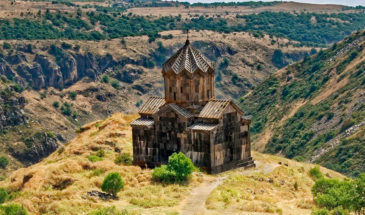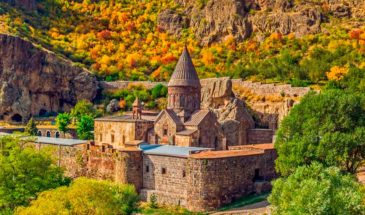- Overview
- Trip Outline
- Trip Includes
- Trip Excludes
- Gallery
- Booking
- FAQ
From ancient monuments to modern cities. This tour is specially designed not only with a visit to historical and cultural attractions, but also with participation in excavations. And also our beloved capital will surprise you with a combination of vintage streets and modern buildings.
Your Armenian adventure begins with a warm welcome at Zvartnots International Airport, leading you to explore Yerevan's active streets, visiting the Republic Square, the Cascade, and the Tsitsernakaberd Genocide Museum, before settling down for the night in the city's heart.
The next phase of your journey takes you on an archaeological exploration to Agarak, where you participate in excavations near Mount Aragats and Lake Amberd, discovering Bronze Age "ritual" buildings. This day of discovery extends to the village Aghtsk, the resting place of the Armenian kings Arshakids, before winding down in Byurakan.
Continuing in Aghtsk, you explore the IV century tomb of the Armenian Arshakouni kings, revealing stories of battles and beliefs carved in stone, culminating with a reflective return to Byurakan.
Your journey continues through Udjan to the XIII century Monastery Tegher, showcasing Armenia's religious architectural splendor, and ends in Amaras, with another peaceful night in Byurakan.
Heading towards Amberd, you explore the fortress's ancient stones and the historical depth of Dashtadem, including the monastery of St. Christopher and the intriguing Kaheniyskoy fortress, before making your way back to Yerevan.
A visit to the Garni pagan temple and the UNESCO-listed Geghard Monastery offers a spiritual reflection on Armenia's past, leading back to Yerevan for the night.
Erebuni's ancient fortress stands as a testament to Armenia's strategic and royal past, leading to the sacred grounds of Echmiadzin and the archaeological richness of Metsamor, with a final stop at the ruins of Zvartnots, another UNESCO heritage site, before retreating to Yerevan.
On your departure day, filled with the memories of Armenia's stunning landscapes, ancient ruins, and the warmth of its people, you are escorted back to the airport, concluding a journey that weaves through Armenia's rich tapestry of history, culture, and spirit.
No details found.
Itineraries
Day 1
Meeting at “Zvartnots” International Airport
Transfer to a centrally located hotel. Yerevan City tour: the Republic Square, the Cascade, the main streets, Tsitsernakaberd (Genocide Museum), Matenadaran. Overnight.
Day 2
Yerevan – Agarak – Aghtsk
Breakfast at the hotel. You will have the archeological trip to Agharak where you will take part in the excavations. The monument is situated near the southern approaches of the mount Aragats, on the shores of the Lake Amberd. Its territory is about 200 ha which has become a cultural-historical reserve by the RA allowance. The “ritual” buildings are of great importance there. The latter comes from the bronze Age. The excavations of 2001-2008 state that there have been inhabitants in Agarak in the Bronze Age too. Tour to the village Aghtsk. The burial of the Armenian kings Arshakids is located in the village Aghtsk. Here the three-nave basilica church is located. The church, which is built of black, yellow tuff and using lime mortar was subjected to considerable damage. Only the lower part of the pylons and walls, fragments of stones with inscriptions and sculptured decorations were survived. Overnight in Byurakan.
Day 3
Excavations of Aghtsk
Breakfast at the hotel. Continuation of the excavations. Armenian Arshakouni kings’ tomb in the village is a construction of the IV century. The remains of the Armenian kings were selected from the Persians, trying to take them to Persia, believing that it will add them to fame and reburied in the village Aghtsk. This building dates back to 359 -360 year. The tomb is illuminated only by the light coming through the door opening. At the entrance stone pillars preserved bas-reliefs of hunting scenes. According to the legend on the left of the entrance pagan kings of the dynasty Arshakids were buried and on the right, near the bas-relief with a cross – buried kings had accepted Christianity. Sarcophagi are decorated with bas-reliefs of the IV century. On the right Christian sarcophagus depicts a warrior with a spear hitting the boar. Scene bout a man with boar symbolizes the war between Armenia and Persia, as the boar was depicted on the seal of the Persian king. Close to the tomb there is a church, built in the IV century. Its ruins have survived. The temple and tomb were built on the edge of the gorge, the bottom of which flows the river Amberd. There are high walls and columns near the both sides of the gorge. Return back to Yerevan. Overnight in Byurakan.
Day 4
Aghtsk –Udjan – Tegher – Amaras
Breakfast at the hotel. Trip to Udjan. Afterwards you will visit the Monastery Tegher (XIII century). The monastery complex is built of dark gray basalt on a small hill. It belongs to the type of domed hall with two-story chapels at the four corners. Trip to Amaras. Overnight in Byurakan.
Day 5
Byurakan – Amberd – Dashtadem – Yerevan
Breakfast at the hotel. Trip to Amberd. Amberd fortress is located in the Aragatsotn Marz, 7 km north-west of the village of Byurakan, on the southern slope of Mount Aragats, on a triangular plateau at the confluence of Arkashen and Amberd. Tour to fortress Dashtadem near the village Dashtadem, on the territory of historical settlement Kaheni. Here is the monastery of St. Christopher. It consists of a small cross-domed church (VIIv.). To the north there is a three-tiered bell tower tomb, residential buildings (now demolished), fortification of unsquared stones and a cemetery with lots of cross-stones (X-XIV centuries.). On the southern edge of the village there is a large architectural complex Kaheniyskoy fortress, while the base of which is unknown, it is assumed that it was built on the site of the Urartian fortress during the reign of the princes Kamsarakanov. Return back to Yerevan. Overnight.
Day 6
Yerevan – Garni – Geghard – Yerevan
Breakfast at the hotel. Visit to Garni pagan temple (I Century AD).Trip to Geghard Monastery, UNESCO World Heritage Site. Return back to Yerevan. Overnight.
Day 7
Yerevan – Erebuni – Echmiadzin – Metsamor – Zvartnots – Yerevan
Breakfast at the hotel. Visiting the fortress of Erebuni atop the Arin Berd hill. Erebuni Fortress was built on top of a hill as a strategic military center and royal residence in 782 BC. Then tour to Echmiadzin – the holy center of Armenia and the Holy See of the Armenian Catholicos. Here you will visit Echmiadzin – the main cathedral (4th century), the church of St.. Gayane (7th century), St. Hripsime (7th century), St. Shogakat (17th century). All of them are included in the UNESCO World Heritage List. Then a trip to the castle Metsamor which has been inhabited since the 5th millennium BC to 18th century AD. Visit to the Museum of History and Archaeology which opened in 1968. Here you can see about 22,000 copies which were found in the fortress and cemeteries from the early Bronze Age to the Middle Ages. Return to Yerevan with a stop at the ruins of Zvartnots (7th century). Zvartnots is also included in the UNESCO World Heritage List. Overnight at the hotel.
Day 8
Departure day
Transfer to the airport.
Accommodation at a centrally located hotel
Breakfasts
Transportation by an air-conditioned vehicle
Professional English-speaking guide
Entrance tickets
Extra meal
No Details Found








